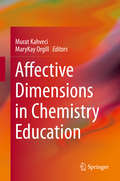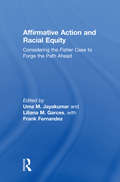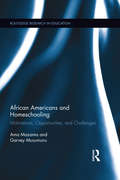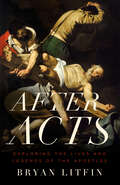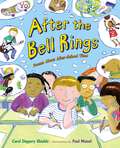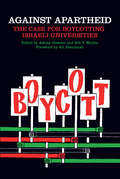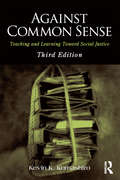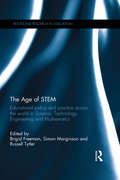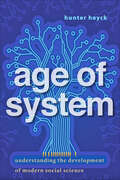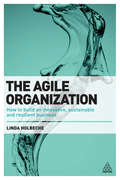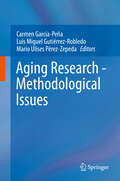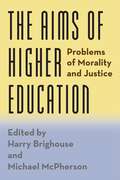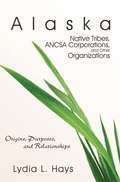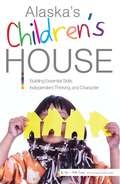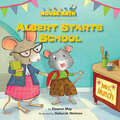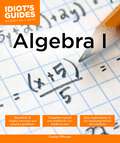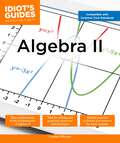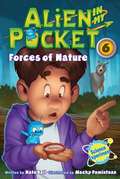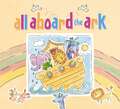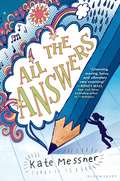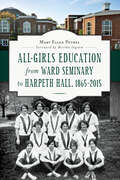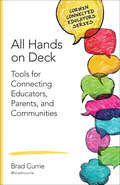- Table View
- List View
Affective Dimensions in Chemistry Education
by Murat Kahveci Marykay OrgillThis is a unique resource for those wishing to address the affective domain as they research and solve problems in chemistry education. Contributions by world-leading experts cover both fundamental considerations and practical case studies. This work fills a gap in the literature of chemistry education, which so far has focussed mainly on the cognitive domain. The affective domain refers to feelings-based constructs such as attitudes, values, beliefs, opinions, emotions, interests, motivation, and a degree of acceptance or rejection. It can affect students' interest in science topics and their motivation to persevere in learning science concepts.
Affirmative Action and Racial Equity: Considering the Fisher Case to Forge the Path Ahead
by Uma M. Jayakumar Liliana M. GarcesThe highly anticipated U.S. Supreme Court decision in Fisher v. University of Texas placed a greater onus on higher education institutions to provide evidence supporting the need for affirmative action policies on their respective campuses. It is now more critical than ever that institutional leaders and scholars understand the evidence in support of race consideration in admissions as well as the challenges of the post-Fisher landscape. This important volume shares information documented for the Fisher case and provides empirical evidence to help inform scholarly conversation and institutions’ decisions regarding race-conscious practices in higher education. With contributions from scholars and experts involved in the Fisher case, this edited volume documents and shares lessons learned from the collaborative efforts of the social science, educational, and legal communities. Affirmative Action and Racial Equity is a critical resource for higher education scholars and administrators to understand the nuances of the affirmative action legal debate and to identify the challenges and potential strategies toward racial equity and inclusion moving forward.
African American Studies Kennedy-King College
by Editors at the PearsonThis book on African American studies covers topics like : Black People in Colonial North America,The Meaning of Freedom: The Promise of Reconstruction,The Failure of Reconstruction,White Supremacy Triumphant,Black Nationalism, Black Power, Black Arts etc.
African Americans and Homeschooling: Motivations, Opportunities and Challenges (Routledge Research in Education #125)
by Ama Mazama Garvey MusumunuDespite greater access to formal education, both disadvantaged and middle-class black students continue to struggle academically, causing a growing number of black parents to turn to homeschooling. This book is an in-depth exploration of the motivations behind black parents’ decision to educate their children at home and the strategies they’ve developed to overcome potential obstacles. Citing current issues such as culture, religion and safety, the book challenges the commonly expressed view that black parents and their children have divested from formal education by embracing homeschooling as a constructive strategy to provide black children with a valuable educational experience.
After Acts: Exploring the Lives and Legends of the Apostles
by Bryan LitfinWhat really happened after Acts?If you&’ve ever wondered what happened to the biblical characters after Acts—from the well-known Matthew to the lesser-known Bartholomew—then this book is for you. Join Dr. Bryan Litfin as he guides you through Scripture and other ancient literature to sift fact from fiction, real-life from legend. Skillfully researched and clearly written, After Acts is as accurate as it is engaging. Gain a window into the religious milieu of the ancient and medieval church. Unearth artifacts and burial sites. Learn what really happened to your favorite characters and what you should truly remember them for.Did Paul ever make it to Spain? Was he beheaded in Rome?Is it true that Peter was crucified upside down?Was the Virgin Mary really bodily assumed into heaven?The book of Acts ends at chapter 28. But its characters lived on.
After Acts: Exploring the Lives and Legends of the Apostles
by Bryan LitfinWhat really happened after Acts?If you&’ve ever wondered what happened to the biblical characters after Acts—from the well-known Matthew to the lesser-known Bartholomew—then this book is for you. Join Dr. Bryan Litfin as he guides you through Scripture and other ancient literature to sift fact from fiction, real-life from legend. Skillfully researched and clearly written, After Acts is as accurate as it is engaging. Gain a window into the religious milieu of the ancient and medieval church. Unearth artifacts and burial sites. Learn what really happened to your favorite characters and what you should truly remember them for.Did Paul ever make it to Spain? Was he beheaded in Rome?Is it true that Peter was crucified upside down?Was the Virgin Mary really bodily assumed into heaven?The book of Acts ends at chapter 28. But its characters lived on.
After the Bell Rings: Poems About After-School Time
by Carol Diggory ShieldsFresh, funny, and full of verve and variety, this clever book of 22 illustrated poems about school captures what kids love to do when class lets out. “Finally…. Finally…. Finally…. BRINNNNNG!That wonderful bell begins to ring. “Everyone knows that the best part of the school day is the moment it ends! After school, kids can hang out with their friends, play video games, attend music lessons, avoid chores, practice sports, do homework...well, maybe that last part isn't so great, but the rest is a blast!
Against Apartheid: The Case for Boycotting Israeli Universities
by Ashley Dawson Bill V. MullenFocusing on the complicity of Israeli universities in maintaining the occupation of Palestine, and on the repression of academic and political freedom for Palestinians, Against Apartheid powerfully explains why scholars and students throughout the world should refuse to do business with Israeli institutions. This rich collection of essays is a handbook for scholars and activists.
Against Common Sense: Teaching and Learning Toward Social Justice
by Kevin K. KumashiroThe phrase "teaching for social justice" is often used, but not always explained. What does it look like to teach for social justice? What are the implications for anti-oppressive teaching across different areas of the curriculum? Drawing on his own experiences teaching diverse grades and subjects, leading author and educator Kevin Kumashiro examines various aspects of anti-oppressive teaching and learning in six different subject areas. Celebrating 10 years as a go-to resource for K-12 teachers and teacher educators, this third edition of the bestselling Against Common Sense features: • A new introduction that addresses the increased challenges of anti-oppressive teaching in an era of teacher evaluations, standardization and ever-increasing accountability. • End of chapter teacher responses that provide subject-specific examples of what anti-oppressive teaching really looks like in the classroom.• End of chapter questions for reflection that will enhance comprehension and help readers translate abstract ideas into classroom practice. • Additional readings and resources to inspire students to further their social justice education. Compelling and accessible, Against Common Sense continues to offer readers the tools they need to begin teaching against their common sense assumptions and toward social justice.
The Age of STEM: Educational policy and practice across the world in Science, Technology, Engineering and Mathematics (Routledge Research in Education)
by Brigid Freeman, Simon Marginson and Russell TytlerAcross the world STEM (learning and work in Science, Technology, Engineering and Mathematics) has taken central importance in education and the economy in a way that few other disciplines have. STEM competence has become seen as key to higher productivity, technological adaptation and research-based innovation. No area of educational provision has a greater current importance than the STEM disciplines yet there is a surprising dearth of comprehensive and world-wide information about STEM policy, participation, programs and practice. The Age of STEM is a state of the art survey of the global trends and major country initiatives in STEM. It gives an international overview of issues such as: STEM strategy and coordination curricula, teaching and assessment women in STEM indigenous students research training STEM in the graduate labour markets STEM breadth and STEM depth The individual chapters give comparative international analysis as well as a global overview, particularly focusing on the growing number of policies and practices in mobilising and developing talent in the STEM fields. The book will be of particular interest to anyone involved in educational policy, those in education management and leaders in both schooling and tertiary education. It will have a wider resonance among practitioners in the STEM disciplines, particularly at university level, and for those interested in contemporary public policy.
Age of System: Understanding the Development of Modern Social Science
by Hunter HeyckIn the years after World War II, a new generation of scholars redefined the central concepts and practices of social science in America.Before the Second World War, social scientists struggled to define and defend their disciplines. After the war, "high modern" social scientists harnessed new resources in a quest to create a unified understanding of human behavior—and to remake the world in the image of their new model man.In Age of System, Hunter Heyck explains why social scientists—shaped by encounters with the ongoing "organizational revolution" and its revolutionary technologies of communication and control—embraced a new and extremely influential perspective on science and nature, one that conceived of all things in terms of system, structure, function, organization, and process. He also explores how this emerging unified theory of human behavior implied a troubling similarity between humans and machines, with freighted implications for individual liberty and self-direction. These social scientists trained a generation of decision-makers in schools of business and public administration, wrote the basic textbooks from which millions learned how the economy, society, polity, culture, and even the mind worked, and drafted the position papers, books, and articles that helped set the terms of public discourse in a new era of mass media, think tanks, and issue networks. Drawing on close readings of key texts and a broad survey of more than 1,800 journal articles, Heyck follows the dollars—and the dreams—of a generation of scholars that believed in "the system." He maps the broad landscape of changes in the social sciences, focusing especially intently on the ideas and practices associated with modernization theory, rational choice theory, and modeling. A highly accomplished historian, Heyck relays this complicated story with unusual clarity.
The Agile Organization
by Linda Holbeche“Agility” is the ability to continuously adapt to rapidly changing circumstances, while “resilience” is being able to bounce back from setbacks. Resilience is essential if a company’s benefits are to endure in the long run and if their employees’ loyalty is to be kept. The Agile Organization focuses on how to build both agility and resilience at individual, team, and organizational levels. Author Linda Holbeche puts the process of developing agile strategy, structures, and processes into the big picture context. This book provides OD/HR practitioners with ways to be effective in a 24/7 business culture, to recognize and avoid the pitfalls of achieving agility without also building organizational resilience, and to understand the importance of involving people in transforming organizations for greater agility. Combining case studies, self-assessment tools, guidelines, and practical checklists with theory, Holbeche explains how to achieve organizational agility while also maintaining and enhancing employee engagement and resilience.
Aging Research - Methodological Issues
by Carmen García-Peña, Luis Miguel Gutiérrez-Robledo and Mario Ulises Pérez-ZepedaThis book reviews classical epidemiological and clinical research studies, with a focus on aging. Chapters cover methodological topics like the scientific method, ethics, and the consequences of certain exclusion criteria and the work includes a look at clinical concepts like multi morbidity, frailty and functionality. The authors reveal the issues and challenges for researchers of age and aging, and also consider the translation of scientific knowledge, from basic to clinical and from clinical to public policies of social and health care.The focus on aging is what gives this book its valuable perspective on research methodology. All authors have considerable experience in aging, geriatrics or gerontology and each chapter includes both a theoretical framework and practical examples of studies in aging. Readers will discover study designs that are reviewed for basic structure, main flaws and advantages and are analyzed for specific conditions and variables regarding aging.This text is suited to both health care professionals caring for older adults and researchers who are new to research in aging. It is relevant across the disciplines, including medicine, psychology, social sciences and dentistry and it supports learning with graphs and figures.
The Aims of Higher Education: Problems of Morality and Justice
by Harry Brighouse Michael McphersonIn this book, philosopher Harry Brighouse and Spencer Foundation president Michael McPherson bring together leading philosophers to think about some of the most fundamental questions that higher education faces. Looking beyond the din of arguments over how universities should be financed, how they should be run, and what their contributions to the economy are, the contributors to this volume set their sights on higher issues: ones of moral and political value. The result is an accessible clarification of the crucial concepts and goals we so often skip over--even as they underlie our educational policies and practices. The contributors tackle the biggest questions in higher education: What are the proper aims of the university? What role do the liberal arts play in fulfilling those aims? What is the justification for the humanities? How should we conceive of critical reflection, and how should we teach it to our students? How should professors approach their intellectual relationship with students, both in social interaction and through curriculum? What obligations do elite institutions have to correct for their historical role in racial and social inequality? And, perhaps most important of all: How can the university serve as a model of justice? The result is a refreshingly thoughtful approach to higher education and what it can, and should, be doing.
The Aims of Higher Education: Problems of Morality and Justice
by Harry Brighouse Michael McPhersonIn this book, philosopher Harry Brighouse and Spencer Foundation president Michael McPherson bring together leading philosophers to think about some of the most fundamental questions that higher education faces. Looking beyond the din of arguments over how universities should be financed, how they should be run, and what their contributions to the economy are, the contributors to this volume set their sights on higher issues: ones of moral and political value. The result is an accessible clarification of the crucial concepts and goals we so often skip over—even as they underlie our educational policies and practices. The contributors tackle the biggest questions in higher education: What are the proper aims of the university? What role do the liberal arts play in fulfilling those aims? What is the justification for the humanities? How should we conceive of critical reflection, and how should we teach it to our students? How should professors approach their intellectual relationship with students, both in social interaction and through curriculum? What obligations do elite institutions have to correct for their historical role in racial and social inequality? And, perhaps most important of all: How can the university serve as a model of justice? The result is a refreshingly thoughtful approach to higher education and what it can, and should, be doing.
Alaska Native Tribes,ANCSA Corporations, and Other Organizations: Origins, Purposes, and Relationships
by Lydia HaysLearn about Alaska's unique indigenous people who have lived thousands of years in a subsistence economy and unconquered. See how today's Alaska Native people exhibit remarkable resilience and adaptability despite the arrival of foreigners to Alaska in the mid-1700s, who sought natural resources and brought death and disease that claimed many indigenous lives. Clear descriptions, facts, charts, lists, and maps tell about the 230 Alaska Native tribes and more than 350 Alaska Native-owned for profit and nonprofit organizations that have emerged over the past 65 years. A stunning 25,000 year timeline depicts archeological sites which helped provide the basis for aboriginal land rights in the historic Alaska Native Land Claims Settlement in 1971. Today, Alaska Native people comprise about 20 percent of Alaska's population and their institutions are a major player in Alaska's diverse economy. Easy to read, you will gain an essential understanding about these modern institutions that have been successfully integrated with traditional subsistence values and are improving the lives of Alaska Native people and all of Alaska.
Alaska's Children's House: Building Essential Skills, Independent Thinking, and Character
by Verna EuwerPreschool is a time in a child's life when adults can stimulate a child's brain to grow as they pass through the various stages of childhood. These changes should involve their motor and sensory functions through experiences in their environment. The purpose of a preschool should be to lay the groundwork to build on for the future. Certainly, it should not be to make little academic wizards of the children. Instead, there should be devices to help children refine the needed essential skills in life, opportunity to improve their motor skills, be introduced to some of the basics of the academic world, learn about the community in which they live, and yet remain a young child in heart and soul. Alaska's Children's House gives you ideas for all these.
Albert Starts School: Days Of The Week (Mouse Math)
by Eleanor MayEach read-aloud book in the Mouse Math series focuses on a single, basic math concept and features adorable mice, Albert and Wanda, who live in a People House. Entertaining fiction stories capture kids&’ imaginations as the mice learn about numbers, shapes, sizes and more. Over 3 million copies sold worldwide!Albert can't wait for his very first day of school. But when Monday arrives, he finds that being at school is a lot different from being at home. Albert is in for a week full of surprises! Every Mouse Math title includes back matter activities that support and extend reading comprehension and math skills, plus free online activities. (Math concept: Days of the Week)
Algebra I (Idiot's Guides)
by Carolyn WheaterStarting with the very basics and reinforcing concepts with practice and tips along the way, Idiot's Guides: Algebra I makes a complex subject easier to grasp and helps students and adult learners clear the hurdle that can stand between them and their academic goals. Special sidebars point out the reasoning behind the techniques (part of essential Common Core instruction) and a separate workbook section offers extra practice problems.
Algebra II (Idiot's Guides)
by Carolyn WheaterPerhaps no subject strikes so much fear in the hearts of high school and college students as Algebra I, except of course its older, meaner sibling, Algebra II! Starting with reinforcing concepts from Algebra I and with lots of practice and tips along the way, Idiot's Guides: Algebra II eases you into second-year algebra to help you master your academic goals. With Common Core instruction in mind, students get: • A natural transition from Algebra I , with a review of relevant concepts and operations. • An in-depth review and expansion of polynomials. • Easy guidance on solving complex rational expressions and radical functions. • Instructions on how to perform operations on polynomials and factoring. • An exploration of exponential and logarithmic functions. • Tips on solving matrices and determinants. • Special sidebars pointing out the reasoning behind the techniques, which is an essential part of Common Core instruction. • Separate workbook section of extra Algebra practice problems — like getting two books in one.
Alien in My Pocket #6: Forces of Nature
by Macky Pamintuan Nate BallZack and Amp get a serious surprise in Forces of Nature, the sixth installment of this fun intergalactic chapter book series by Nate Ball, the host of PBS's Design Squad and Design Squad Nation.Ever since Amp crash-landed his spaceship through Zack McGee's window, Zack's life has gone in some unexpected directions. But when everything goes wrong on the McGee family camping trip, Zack's going to need Amp's alien scouting skills to navigate the great outdoors and find their way back to civilization!Like every book in the Alien in My Pocket series, Forces of Nature mixes Common Core-aligned science with safe, hands-on experiments that young readers will love. This installment includes a build-your-own compass experiment.Publishers Weekly said of Alien in My Pocket: Blast Off!: "With its screwball comedy and lively dialogue, the novel gives readers the opportunity to laugh as they learn."
All Aboard the Ark
by ZondervanSun is high. Rain is coming.God whistles. We come running.All Aboard the Ark pairs simple rhyming text with charming watercolor illustrations in this delightful book. Perfect for bedtime or any time, this sweet story is told from the point of view of the animals who board the ark.
All The Answers
by Kate MessnerFor fans of Wendy Mass and Andrew Clements comes a new, magical middle-grade adventure from Kate Messner. What if your pencil had all the answers? Would you ace every test? Would you know what your teachers were thinking? When Ava Anderson finds a scratched up pencil she doodles like she would with any other pencil. But when she writes a question in the margin of her math quiz, she hears a clear answer in a voice no one else seems to hear. With the help of her friend Sophie, Ava figures out that the pencil will answer factual questions only - those with definite right or wrong answers - but won't predict the future. Ava and Sophie discover all kinds of uses for the pencil, and Ava's confidence grows with each answer. But it's getting shorter with every sharpening, and when the pencil reveals a scary truth about Ava's family, she realizes that sometimes the bravest people are the ones who live without all the answers. . .
All-Girls Education from Ward Seminary to Harpeth Hall: 1865-2015
by Martha Ingram Mary Ellen PethelDuring the final days of the Civil War, Dr. William Ward and his wife, Eliza Ward, envisioned a school for young women in Nashville that would evolve into one of the nation's most prestigious institutions. As the New South dawned, Ward Seminary opened its doors in September 1865. Merging with Belmont College for Young Women in 1913, Ward-Belmont operated as a college preparatory school, music conservatory, and junior college. In 1951, the high school division moved farther west, reopening as the Harpeth Hall School after Ward-Belmont's sudden closure. Ward Seminary, Belmont College, Ward-Belmont, and Harpeth Hall are simply separate chapters of one continuous story. As Harpeth Hall celebrates 150 years, its story reflects a unique case study and provides a lens through which to understand the evolution of all-girls education in the United States. The Harpeth Hall School remains one of the oldest all-girls college preparatory schools in the South.
All Hands on Deck: Tools for Connecting Educators, Parents, and Communities (Corwin Connected Educators Series)
by Brad M. CurrieBring communities together for involvement that makes a difference! Impact your students in a positive way and join the leagues of educators who are learning to engage with students, parents, and communities using social media and Web 2.0 technologies. Featuring practical strategies that you’ll want to put to use right away, plus a dedicated series website for additional resources, this short and easy-to-follow book will show you: How smartphones and tablets can work for your goals The secret to getting—and keeping—parents involved How to inform, engage, and empower stakeholders How tools like Skype can connect the community at large The Corwin Connected Educators series is your key to unlocking the greatest resource available to all educators: other educators. Being a Connected Educator is more than a set of actions: it’s a belief in the potential of technology to fuel lifelong learning. "Currie harnesses the key element in today’s social media-infused school environment—‘Knowledge is Power!’ He illustrates just how we need to use this knowledge to support our schools, students, and communities." Daisy Dyer Duerr, Principal St. Paul Public Schools "This book provides educators with a diversified look at the connections schools can make with technology. It will inspire all of us, on a global scale, to stay active in ways once thought unimaginable." Salome Thomas-EL, Award-winning principal and author
